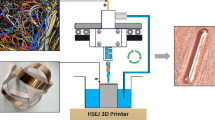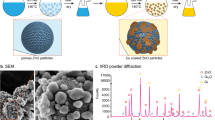Abstract
Recently, the direct ink writing (DIW) of hierarchical porous copper \((Cu)\) (HP-\({\text{Cu}}\)) for lithium metal battery applications has attracted significant attention. To achieve this, \(Cu\) ink with ideal rheological properties and high particle loading is necessary. However, to date, no work focusing on systematic \(Cu\) ink development with \(Cu\) particle loading more than 95 \(wt\%\) has been reported. Hence, in the present work, a novel \(Cu\) ink with a particle loading of more than 95 \(wt\%,\) and polylactic acid (PLA) as a binder has been developed. The rheological behavior of the \(Cu\) ink with different amounts of \(Cu\) loading i.e. 93, 95 and 97 \(wt\%\) respectively were investigated. Moreover, the modelling using the Herschel-Bulkey equation was done to establish the rheology. All the prepared inks showed viscoelastic and shear thinning behaviour. Moreover, the ink having 97\(wt\%\) \(Cu\) loading exhibited optimum rheology with a shear elastic modulus of around \({10}^{5} Pa\) in the linear viscoelastic area. Subsequently, DIW using the prepared \(Cu\) inks followed by sintering was performed. The morphological study of the 3D printed \(Cu\) green samples and sintered samples was performed and it was found that the variation in \(Cu\) particle loading significantly affected the density and volumetric shrinkage. Finally, an HP-\({\text{Cu}}\) sample having a pore size less than 200 \(\mu m\) was fabricated using DIW and sintering to validate the efficacy of the developed \(Cu\) ink. Proper interparticle bonding between the \(Cu\) particles was observed indicating that the developed ink is suitable for the fabrication of complex \(Cu\) parts for lithium metal battery application.












Similar content being viewed by others
Data availability
Not applicable.
References
L. del Mazo-Barbara, M.P. Ginebra, Rheological characterisation of ceramic inks for 3D direct ink writing: a review. J. Eur. Ceram. Soc. 41(16), 18–33 (2021). https://doi.org/10.1016/j.jeurceramsoc.2021.08.031
X. Ke et al., Hierarchically bicontinuous porous copper as advanced 3D skeleton for stable lithium storage. ACS Appl. Mater. Interfaces 10(16), 13552–13561 (2018). https://doi.org/10.1021/acsami.8b01978
M. Pei et al., 3D printing of advanced lithium batteries: a designing strategy of electrode/electrolyte architectures. J. Mater. Chem. A 9(45), 25237–25257 (2021). https://doi.org/10.1039/d1ta06683h
C. Sun, S. Liu, X. Shi, C. Lai, J. Liang, Y. Chen, 3D printing nanocomposite gel-based thick electrode enabling both high areal capacity and rate performance for lithium-ion battery. Chem. Eng. J. (2020). https://doi.org/10.1016/j.cej.2019.122641
L. Liu, J. Lyu, T. Zhao, T. Li, Preparations and properties of porous copper materials for lithium-ion battery applications. Chem. Eng. Commun. 203(6), 707–713 (2016). https://doi.org/10.1080/00986445.2015.1104504
G.J.H. Lim et al., Robust pure copper framework by extrusion 3D printing for advanced lithium metal anodes. J. Mater. Chem. A Mater. 8(18), 9058–9067 (2020). https://doi.org/10.1039/d0ta00209g
M. Wei, F. Zhang, W. Wang, P. Alexandridis, C. Zhou, G. Wu, 3D direct writing fabrication of electrodes for electrochemical storage devices. J. Power. Sources 354, 134–147 (2017). https://doi.org/10.1016/j.jpowsour.2017.04.042
C. Chen et al., 3D printed lithium-metal full batteries based on a high-performance three-dimensional anode current collector. ACS Appl. Mater. Interfaces (2021). https://doi.org/10.1021/acsami.1c03997
J.A. Lewis, Direct-write assembly of ceramics from colloidal inks. Curr. Opin. Solid State Mater. Sci. (2002). https://doi.org/10.1016/S1359-0286(02)00031-1
S.S. Hossain, K. Lu, Recent progress of alumina ceramics by direct ink writing: ink design, printing and post-processing. Ceram. Int. 49(7), 10199–10212 (2023). https://doi.org/10.1016/j.ceramint.2023.01.143
A. M’Barki, L. Bocquet, A. Stevenson, Linking rheology and printability for dense and strong ceramics by direct ink writing. Sci. Rep. (2017). https://doi.org/10.1038/s41598-017-06115-0
Y. Sun, C. Peng, X. Wang, R. Wang, J. Yang, D. Zhang, Rheological behavior of Al2O3 suspensions containing polyelectrolyte complexes for direct ink writing. Powder Technol. 320, 223–229 (2017). https://doi.org/10.1016/j.powtec.2017.07.049
T. Chen et al., Rheological behavior of Titania ink and mechanical properties of Titania ceramic structures by 3D direct ink writing using high solid loading Titania ceramic ink. J. Alloys Compd. 783, 321–328 (2019). https://doi.org/10.1016/j.jallcom.2018.12.334
M. Yarahmadi, P. Barcelona, G. Fargas, E. Xuriguera, J.J. Roa, Optimization of the ceramic ink used in direct ink writing through rheological properties characterization of zirconia-based ceramic materials. Ceram. Int. 48(4), 4775–4781 (2022). https://doi.org/10.1016/j.ceramint.2021.11.013
C. de Backere, T. De Beer, C. Vervaet, V. Vanhoorne, Effect of binder type and lubrication method on the binder efficacy for direct compression. Int. J. Pharm. (2021). https://doi.org/10.1016/j.ijpharm.2021.120968
S.B. Balani, S.H. Ghaffar, M. Chougan, E. Pei, E. Şahin, Processes and materials used for direct writing technologies: a review. Results Eng. (2021). https://doi.org/10.1016/j.rineng.2021.100257
S.L. Taylor, A.E. Jakus, R.N. Shah, D.C. Dunand, Iron and nickel cellular structures by sintering of 3D-printed oxide or metallic particle inks. Adv. Eng. Mater. (2017). https://doi.org/10.1002/adem.201600365
B.K. Park, D. Kim, S. Jeong, J. Moon, J.S. Kim, Direct writing of copper conductive patterns by ink-jet printing. Thin Solid Films 515(19), 7706–7711 (2007). https://doi.org/10.1016/j.tsf.2006.11.142
S. Mooraj et al., Three-dimensional hierarchical nanoporous copper via direct ink writing and dealloying. Scr. Mater. 177, 146–150 (2020). https://doi.org/10.1016/j.scriptamat.2019.10.013
L. Biasetto, A. Gleadall, V. Gastaldi, Ink tuning for direct ink writing of planar metallic lattices. Adv. Eng. Mater. (2023). https://doi.org/10.1002/adem.202201858
D. Callegari, L. Airoldi, R. Brucculeri, U. Anselmi Tamburini, E. Quartarone, Extrusion 3D printing of patterned CU current collectors for advanced lithium metal anodes. Batter Supercaps (2023). https://doi.org/10.1002/batt.202300202
V. Egorov, C. O’Dwyer, Architected porous metals in electrochemical energy storage. Curr. Opin. Electrochem. 21, 201–208 (2020). https://doi.org/10.1016/j.coelec.2020.02.011
D.K. Mishra, P.M. Pandey, Experimental investigation into the fabrication of green body developed by micro-extrusion-based 3D printing process. Polym. Compos. 41(5), 1986–2002 (2020). https://doi.org/10.1002/pc.25514
N. Dehdari Ebrahimi, Y.S. Ju, Thermal conductivity of sintered copper samples prepared using 3D printing-compatible polymer composite filaments. Addit. Manuf. 24, 479–485 (2018). https://doi.org/10.1016/j.addma.2018.10.025
J. Laureto, J. Tomasi, J.A. King, J.M. Pearce, Thermal properties of 3-D printed polylactic acid-metal composites. Prog. Additive Manufact. 2(1–2), 57–71 (2017). https://doi.org/10.1007/s40964-017-0019-x
J.A. Lewis, J.E. Smay, J. Stuecker, J. Cesarano, Direct ink writing of three-dimensional ceramic structures. J. Am. Ceram. Soc. 89(12), 3599–3609 (2006). https://doi.org/10.1111/j.1551-2916.2006.01382.x
P. Saramito, A new elastoviscoplastic model based on the Herschel-Bulkley viscoplastic model. J. Nonnewton. Fluid Mech. 158(1–3), 154–161 (2009). https://doi.org/10.1016/j.jnnfm.2008.12.001
X.Y. Teoh, B. Zhang, P. Belton, S.Y. Chan, S. Qi, the effects of solid particle containing inks on the printing quality of porous pharmaceutical structures fabricated by 3D semi-solid extrusion printing. Pharm. Res. 39(6), 1267–1279 (2022). https://doi.org/10.1007/s11095-022-03299-7
M. Yamada, T. Watanabe, T. Gunji, J. Wu, F. Matsumoto, Review of the design of current collectors for improving the battery performance in lithium-ion and post-lithium-ion batteries. Electrochem 1(2), 124–159 (2020). https://doi.org/10.3390/electrochem1020011
J. Chen et al., Porous metal current collectors for alkali metal batteries. Adv. Sc. (2023). https://doi.org/10.1002/advs.202205695
S. Zhang, Y. Liu, J. Hao, G.G. Wallace, S. Beirne, J. Chen, 3D-printed wearable electrochemical energy devices. Adv. Funct. Mater. (2022). https://doi.org/10.1002/adfm.202103092
Funding
This work is supported by Department of Science and Technology-Science and Engineering Research Board (DST-SERB), New Delhi, India (Grant reference no. CRG/2023/003836).
Author information
Authors and Affiliations
Contributions
Vivek Mani Tripathi : Writing, Investigation, Conceptualization, and Visualization Dr.Pawan Sharma: conceptualization, supervision, writing, and editing. Prof. (Dr.) Rajnesh Tyagi - Supervision, Writing, Review, & Editing.
Corresponding author
Ethics declarations
Competing interests
The authors declare no competing interests.
Ethical approval
No ethical approval is required for the work.
Additional information
Publisher's Note
Springer Nature remains neutral with regard to jurisdictional claims in published maps and institutional affiliations.
Supplementary Information
Below is the link to the electronic supplementary material.
Supplementary file1 (MP4 18211 KB)
Rights and permissions
Springer Nature or its licensor (e.g. a society or other partner) holds exclusive rights to this article under a publishing agreement with the author(s) or other rightsholder(s); author self-archiving of the accepted manuscript version of this article is solely governed by the terms of such publishing agreement and applicable law.
About this article
Cite this article
Tripathi, V.M., Sharma, P. & Tyagi, R. Development of a high particle loading novel copper ink for the fabrication of a three-dimensional hierarchical porous structure using direct ink writing and sintering. J Porous Mater (2024). https://doi.org/10.1007/s10934-024-01579-8
Accepted:
Published:
DOI: https://doi.org/10.1007/s10934-024-01579-8




